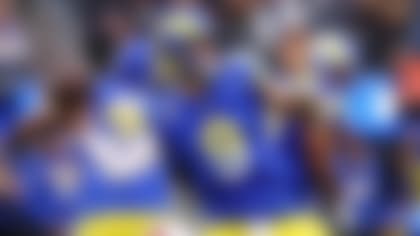Top underclassmen:
» Offense: Quarterbacks | Running backs | Wide receivers/tight ends | Linemen
» Defense: Linemen/linebackers | Defensive backs
Wide receivers
Keenan Allen
College: California
Height: 6-3 Weight: 206
Allen intercepted 17 passes over the final two years of an All-American high school career, but he also scored 79 touchdowns (53 as a senior) on offense -- numbers that convinced Cal coaches to play him on that side of the ball. He repaid that confidence, starting nine games and becoming the team's second-leading receiver in his first season. Allen racked up 120 of his season-total 490 yards in the opener against UC-Davis and eventually set a school record for freshmen with 46 receptions (eclipsing Philadelphia Eagles star receiver DeSean Jackson, who had 38). He also returned 18 kickoffs, posting a 22.6-yard average.
Other teams' coaches were also impressed with Allen's game; after his sophomore campaign, he was named first-team all-conference. He ranked in the top 10 nationally in receptions (98) and receiving yards (1,343), buoyed by a 13-catch, 160-yard effort against USC. Allen also scored six times, increasing his career touchdown total to 11. Allen missed 2012 spring practices after having surgery on his ankle, but he is expected to again catch passes from Cal quarterback Zach Maynard, who happens to be his half-brother. (A senior lefty passer, Maynard transferred from Buffalo after the 2009 season.)
Strengths: A long-legged and reliable No. 1 receiver prospect, Allen runs solid slants, crossers, speed outs and vertical routes. He has the height to win jump balls downfield and will attack the ball in the air with his hands. He lines up in the slot regularly, can get off the press with a quick shake at the line and uses his frame to block out smaller corners. An agile ball-carrier after the catch, he can make the first man miss with a quick cut or spin away from tackle attempts, maintaining his balance to continue downfield. He also runs through smaller corners to pick up a few extra yards. Gets down quickly for low throws despite his height. An aware receiver who uses his hands to create space from defenders downfield and gives his quarterback a target when in scramble mode.
Weaknesses: Has strider's speed that is good enough to threaten defenses down the sideline, but is not elite in this category. Does not easily separate from better cornerbacks off the line. Allows some passes into his body when facing the quarterback. He has the occasional drop when extending away from his frame or tracking over his shoulder, but bounces back quickly. Does not utilize his size or length as a run blocker; he does not execute cut blocks and fails, at times, to hit a target.
NFL comparison: Braylon Edwards
Bottom line: A smooth outside pass-catcher, Allen has height, speed and the ability to win jump balls, all traits that are required of a No. 1 target in the NFL.
Robert Woods
College: Southern California
Height: 6-1 Weight: 190
Woods was a consensus All-American in high school, which gave him the chance to matriculate at whatever college he desired. Prolific on the gridiron as a senior (racking up 1,112 receiving yards and eight interceptions), he was also a standout sprinter, anchoring the winning 1,600-meter relay team at the state track meet, where he finished second in the 400-meter dash and third in the 200 meters. It was no surprise that he went to USC instead of following in the footsteps of his father and grandfather, former Grambling State Tigers.
He started all 13 games as a true freshman for the Trojans, earning numerous freshman All-America honors and being named the Pac-12 Offensive Freshman of the Year. He was a first-team All-Pac-12 pick as a kick returner (971 yards, with a touchdown against Minnesota) and received honorable mention as a receiver (65 receptions for 792 yards and six touchdowns). His breakout performance came in the team's heart-breaking 37-35 loss to Stanford, when he covered 224 yards and scored three times on 12 catches. For his follow-up as a sophomore, Woods didn't disappoint. He was a finalist for the Biletnikoff Award after starting every game and finishing the year in the top 10 nationally in receptions (111), receiving yards per game (107.7, with 1,292 total yards) and receiving touchdowns (15). Those 111 catches beat Keyshawn Johnson's Pac-12 and school record, and the 17 receptions that he had in the season opener against Minnesota were the most for any FBS receiver in 2011. He also continued to dazzle as a returner (averaging 9.1 yards on punts and 23.1 on kickoffs) in spite of his stardom on offense. Despite all that success, Woods fought various health problems in 2011, and had postseason arthroscopic surgery on his right ankle because of a pickup basketball injury suffered last spring.
Strengths: Woods is a productive potential No. 1 receiver who can excel at running any route on the tree due to good foot quickness and shifty hips. He runs solid comeback routes and uses sharp cuts on skinny posts to free himself. Possesses good vision and a strong burst with the ball in his hands. Flashes the ability to catch passes away from his frame. He can make catches in traffic and track passes over his shoulder. At times, he shows the strength and agility to spin out of tackle attempts in the secondary. He's willing to go over the middle, take a hit and hang on. Has the speed to run past defenders, but also uses his long arms to create space from defenders downfield. Gives his quarterback a target when plays break down by going deep or coming across the field. Does his job as a downfield blocker on run plays, mixing it up with multiple targets if necessary.
Weaknesses: With lean upper and lower body builds, his strength is an issue when he's trying to get off the jam and fight for 50-50 balls. He has more than his share of drops in some games, failing to secure the ball by squeezing it with his hands. Settles for body catches. Could step in as a kickoff or punt returner in a pinch due to his willingness to run through traffic, but lacks the elusiveness and pure speed most NFL teams covet. Had surgery on his right ankle during the 2012 offseason; did not participate in spring practice.
NFL comparison:Reggie Wayne
Bottom line: The 2011 Biletnikoff Award finalist racked up big numbers with quarterback Matt Barkley, due to his foot quickness and burst after the catch. That right ankle just needs to finally heal and he must show he can catch the ball more consistently downfield.
Justin Hunter
College: Tennessee
Height: 6-4 Weight: 200
Hunter's height, striding speed, explosive leaping ability and easy hands make him an exceptional vertical threat able to take the top off of any defense -- but only when he's on the field. The Volunteers looked like they were on their way to a prolific 2011 season after putting up more than 40 points in each of their first two games. But in the third game of the season, Hunter tore his left anterior cruciate ligament. Without him, Tennessee scored just 92 points in eight conference games.
The Virginia high school All-American and winner of the high-jump competition at the 2010 USA Junior Championships combined with fellow sophomore quarterback Tyler Bray for big yardage against Montana (six catches for 146 yards and one touchdown) and Cincinnati (10 catches for 156 yards and one touchdown) before the injury. This was no surprise, given the flashes of playmaking brilliance he showed while making the SEC's all-freshman squad in 2010. Hunter played in all 13 games that year, starting twice; he had 16 catches for 415 yards (a stout 25.9 yards per reception) and seven touchdowns.
Strengths: He has prototypical height for an outside NFL receiver, though he will line up in the slot to test defenses over the middle. Straight-line speed appears more than sufficient for his size; he can burst past corners down the sideline, and his long strides make it difficult for cornerbacks to recover once he's beaten them. Varies his speed in routes to put defenses off balance; can accelerate with good foot quickness after a lull to create separation on digs and seam routes. Despite his size, possesses enough of a shimmy off the line to lose cornerbacks. With soft hands, he can snatch throws in front of his frame or over either shoulder; with his height and leaping ability, hw will be a threat on jump balls.
Weaknesses: Has a limited number of snaps under his belt. He needs to prove his hands are consistent when tested over a full season. Missed most of his second season with a torn left ACL. He must continue to get stronger throughout his frame to win battles at the line of scrimmage and be able to break away from NFL tacklers. Blocking on run plays is inconsistent at best; he shows little physicality in that realm.
NFL comparison:Roy Williams
Bottom line: Tennessee's tall strider looked to be on his way to a breakout year (17 catches, 314 yards, two touchdowns in just over two games) in 2011 before tearing his left ACL. But he showed enough vertical ability in that season and as a freshman to sincerely whet the appetites of NFL teams looking for a big-play receiver.
Josh Boyce
College: TCU
Height: 5-11 Weight: 203
Boyce was teammates with Robert Griffin III at Copperas Cove High School. And one of their top rivals was Brownwood, the high school of Boyce's current quarterback, Casey Pachall. Now Boyce must rely on his former adversary to get him the ball on short, medium and deep routes. If he does, Boyce can show off his excellent speed, short-area agility and strength -- not unlike what the similarly sized Kendall Wright did with Griffin in 2011.
Boyce redshirted his first season in 2009 but became heavily involved in the Horned Frogs' prolific offense in 2010, when it was quarterbacked by current Cincinnati Bengals starter Andy Dalton. Boyce played in every game, starting eight of the last nine and finishing second on the team in receiving yards (646 on 34 catches) while scoring six touchdowns. As a sophomore, Boyce was a first-team All-Mountain West Conference pick after leading the team in receptions (61), yards (998) and receiving touchdowns (nine).
Strengths: He has a solid overall build with a muscular upper body and strong legs. Lines up outside and in the slot. Excellent first three steps off the line to challenge corners, he shakes them off the line and has enough speed to get a step down the field. Stems every route in the tree with foot quickness that college corners can't handle; he does not have to slow down significantly to make a cut. Goes down to grab low passes but also flashes the ability to go up for high throws. Tracks the ball well over either shoulder. Creates space downfield with an arm extension. Tough to bring down after the catch because of his low center of gravity and strength. He's an aggressive run blocker with the strength to negate his man and stick with the block. Willing to attack safeties stepping up inside if uncovered. Used in motion to prevent defensive ends and linebackers from crashing down on inside runs.
Weaknesses: A bit shorter than scouts would prefer on the outside, making him inconsistent when fighting for jump balls. Does not bring in some of the difficult catches that top prospects are expected to snare with their hands. Must prove his pure straight-line speed, though most college corners couldn't close on him in the open field. Does not consistently sustain run blocks, allowing his man to come off and make a play at times.
NFL comparison: Devery Henderson
Bottom line: Boyce's average height won't impress scouts, but the quickness and strength that make him a playmaker at the college level should allow him to threaten NFL defenses both inside and outside.
Da'Rick Rogers
College: Tennessee Tech
Height: 6-3 Weight: 208
Da'Rick (pronounced DAY-rick) set a Georgia state high school record for receiving yards (1,641) as a senior, but decided to head for Tennessee instead of staying with the home-state Bulldogs -- even after head coach Lane Kiffin left the program for USC. Rogers' career in Knoxville got off to a rocky start, as he was charged with disorderly conduct and resisting arrest outside a bar in July, before his true freshman season even began. New head coach Derek Dooley still got Rogers on the field right away, though he actually had more rushing attempts (16 for 117 yards) and kickoff returns (12 for 298 yards) than receptions (11 for 167 yards and two scores) on the season.
His receiving numbers greatly improved as a sophomore, and his 1,040 yards and nine touchdowns on 67 catches landed him on the coaches' All-SEC second team. His importance to the Volunteers' success (especially after fellow second-year receiver Justin Hunter went down with a torn ACL) was evident; the team was 5-1 in games where he eclipsed 100 yards, and 0-6 when he did not.Rogers' immaturity showed this spring, as he tweeted about transferring when sitting out a practice to take care of "internal issues", according to Dooley, before returning the next day. Eventually, the team decided to dismiss him before the 2012 season, so he transferred to FCS school Tennessee Tech instead of sitting out a season to stay on the major college level.
Strengths: Physical specimen with the talent to become a number one receiver. Strong hands allow him to grab low and wide passes adeptly. Takes hits over the middle and has the body to be effective on slants at the next level. Tough runner after the catch, smaller defensive backs struggle to bring him down. Physical run blocker when engaged, will sustain through the play.
Weaknesses: Off-field maturity and on-field effort have been issues. Stops his route at times if not the primary target. Body language on the field can be defeating. Must work on beating physical corner play in spite of his superior size, gets stuck five yards downfield and doesn't explode past his man. Does not always reach his target as a blocker.
NFL comparison:Greg Little
Bottom line: Rogers is a physical specimen with strong hands who overpowered defenders in his routes and after the catch on his way to second-team All-SEC status in 2011 (67 catches, 1,040 yards, nine TD). His immaturity off the field caused him to be dismissed from Tennessee before the 2012 season, and he's now attending Tennessee Tech. His attributes could still be enough to entice one NFL team to use a second-round pick on his services, even after one season at the FCS level.
DeAndre Hopkins
College: Clemson
Height: 6-1 Weight: 205
When Hopkins makes a play in front of his home crowd, you'll hear the throng cheer "Nuuuk." Though his childhood nickname came from a special brand of baby pacifier he required because he bit through most others, the confident receiver will tell you he's added another reason for that moniker - he feels almost nuclear in his explosion on the field. If he continues to progress as a receiver, NFL scouts will tend to agree he's got a chance to be a significant contributor on Sundays.
The nephew of the late Terry Smith, who caught 162 passes for Clemson from 1990-1993, was yet another top South Carolina recruit the Tigers kept in-state despite great interest from major programs across the country. Hopkins earned the team's Rookie of the Year award in 2010, starting eight of 12 games played and leading the team with 52 catches (covering 637 yards and four touchdowns) - and he joined the Clemson basketball team as a reserve after the season, one year after leading his high school team to a state title. He played in every game, starting 11, as a sophomore in 2011, being somewhat overlooked despite nearly reaching 1,000 receiving yards (978 on 72 catches, also five touchdowns) because of the electric play of freshman Sammy Watkins. Hopkins suffered a mild concussion in a car accident on his way to go to the team's disappointing 70-33 Orange Bowl loss to West Virginia, but he still managed a school bowl-record 10 catches for 107 yards and a touchdown.
Strengths: Presents good height and length for an outside receiver, also has some lower-body strength for explosion off the line of scrimmage and in his cuts. Solid route-runner used in the short, intermediate, and deep games, who has flexibility to avoid corners in zone and the quick feet to separate on hitches, comebacks, and other cuts. Will threaten the top of defenses with NFL-quality straight-line speed. Possesses strong hands in traffic, not afraid of contact downfield and can separate at the last second with an arm extension. Agile enough to quickly avoid oncoming defenders after the catch yet remain balanced to head downfield for the big gain. Does not go down without a fight, can run through arm tackle attempts from cornerbacks. Snatches throws with his hands, even those within his frame. Concentrates on the ball throughout difficult catches and extends his long arms to make a big radius. Sells double-moves well with a head fake and body lean. Has good body control to contort his body on catches, keep one foot in-bounds on the sideline. Effective run blocker, usually reaches his target and gets his hands up, uses correct blocking angle to sustain; also shows some nastiness at times, capable of putting his man to the ground.
Weaknesses: Only average size for a starting outside receiver. Occasionally loses track of the ball on easy catches when trying to make a move too early. Must prove his ability to use his hands to beat press coverage from NFL veterans off the line. Dances around defenders and run backwards after short catches at times, losing his balance or some yardage, instead of heading upfield. Will need to be more consistently physical in the blocking game at the next level.
NFL comparison:Roddy White
Bottom line: Sammy Watkins got a lot of headlines as a true freshman in 2011 because of his exceptional skills, but Clemson's "other" receiver, Hopkins, produced consistently using his NFL body and hands. "Nuke" excited the Death Valley crowds with his big plays as a sophomore (978 yards, five touchdowns), while also intriguing scouts with his potential as an NFL starter outside.
Marquess Wilson
College: Washington State
Height: 6-4 Weight: 185
Wilson's production during his time in Pullman was among the best in the West over the past couple of seasons, but his career will be defined by how it ended. Despite leading the team in receptions (52) and receiving yards (813) with five touchdowns in nine games, he was indefinitely suspended by the program for the ubiquitous "violation of team rules," reportedly after walking out of a physical conditioning session. His comments about the situation were not flattering towards the Cougars' new head coach, Mike Leach; Wilson accused Leach and the coaching staff of belittling, intimidating, and humiliating players throughout the season. Now NFL teams must sort out whether these actions reflect poorly on Leach's staff or Wilson's maturity -- while also trying to weigh his ability to win jump balls and fluid open field movement against his inconsistent hand, to determine whether he is a legitimate first-round talent.
Wilson was a football and track star in Tulare, California, earning accolades at receiver (1,083 yards and 22 touchdowns on 50 catches as a senior) and defensive back on the gridiron while winning conference championships in the high, long and triple jumps. He took on a major role during his true freshman year in the Palouse, playing in all 12 games, starting eightm and leading the team with 1,006 receiving yards (55 catches, six TD) on his way to honorable mention All-Pac-10 notice and Freshman All-American honors from multiple outlets. Wilson was even more production as a sophomore, earning second-team all-conference honors and the Cougars' Offensive Most Valuable Player award by starting all 12 games and setting WSU single-season records with 83 grabs for 1,388 yards (he led the Pac-12 in yards per game), along with scoring 12 times during the season.
Strengths: Tall strider presenting a difficult ask down the sideline for shorter defensive backs. If able to escape the jam or come off the line untouched, he covers a lot of ground in a hurry. His height and vertical jump makes him a nightmare on jump balls anywhere on the field, and he can contort his body to adjust to passes in the air. Makes catches over either shoulder down the sideline and can stay in-bounds. Drops his hips, has quick enough feet and a solid head-fake to separate at the top of the route, as well as to pull off double-moves downfield and to the sideline. Tries to run through tackles by lowering his pads and churning his feet after the catch and has a bit of open-field elusiveness, though he will run backwards and dance too much instead of taking what he can get. Will find a soft spot in the zone if his quarterback is on the run. Flashes an effective use of his length, and a bit of attitude, to take smaller defenders out in the run game.
Weaknesses: Lanky receiver, especially thin in the lower body. Will struggle with the physicality of NFL defenders off the line, when trying to get into his route, and downfield in 50/50 situations. Does not consistently use his hands to win or hold onto the ball when being hit or even feeling the hit coming. Hands reliably is severely lacking, misses on all difficulty of catches due to a lack of concentration. Doesn't adjust to low passes as well as he does high ones. Lateral quickness against press is only average, takes time to accelerate into his route if challenged at all. Lacks technique as a blocker, when he makes the effort to reach his target, tries to overwhelm corners but fails to move his feet or maintain the angle to prevent them from entering the play.
NFL comparison: Jonathan Baldwin
Bottom line: Wilson's exit from Washington State was not exactly ideal, as he was suspended for violating team rules and then ripped Mike Leach and his coaching staff on his way out the door. The 6-foot-4, 185-pound receiver certainly flashed playmaking ability during his two-plus seasons in Pullman, especially in a second-team all-conference sophomore year (83-1,388, 12 touchdowns) where he flashes downfield playmaking ability using his height and excellent leaping ability. If teams believe he can improve the consistency of his hands and mature physically and mentally at the next level, they might consider him worthy of first-round consideration.
Tight ends
Tyler Eifert
College: Notre Dame
Height: 6-6 Weight: 251
Kyle Rudolph's decision to leave a season early for the 2011 NFL Draft (he was picked in the second round by the Minnesota Vikings) opened the door for Eifert to become a star. Despite uncertainty at quarterback, the Irish still have enough talent around Eifert to allow him to show off his receiving skills in 2012.
The son of former Purdue basketball player Greg Eifert led all FBS tight ends with 63 grabs for 803 yards in 2011. With five touchdowns, he was a nice red-zone complement to first-round receiver Michael Floyd. Even with Rudolph starting ahead of him in 2010, Eifert made enough of an impact (27 catches, 352 yards, two touchdowns) as a redshirt freshman to earn the team's Offensive Newcomer of the Year award.
Strengths: Tall frame at 6-foot-6. Lines up with his hand down, in an H-back role, in the slot and outside. Threatens the seam with his long strides off the snap. Takes a lot of hits across the middle and bounces up. Uses his height, length and strong hands to snatch passes out of the air. Flashes quick feet on out cuts to be an effective safety valve. Fights through arm tackles to get extra yardage. Gets off the line effectively from a three-point stance and can shimmy past a defender near the line to get into his route. Gives effort as an in-line blocker and uses his length to hold off defensive ends. He uses agility to get an angle and create outside running lane. Also works hard to prevent defenders from reaching teammates downfield.
Weaknesses: Has a lean, receiver-like build. Does not play with consistent explosiveness and leverage when blocking in-line. He would get pulled down by NFL ends and miss reach-blocks against quicker ends. Stronger linebackers will rip off his blocks and ride him off his route when he does not use his hands effectively. Allows throws into his body on occasion; will drop the ball when trying to run before securing.
NFL comparison:Greg Olsen
Bottom line: If the Irish's issues at quarterback get settled, the tall, sinewy Eifert will cement his status as the top prospect at the position. Considering the impressive seasons put forth by athletic tight ends in the NFL recently, scouts will look for Eifert to step up and become the next Jimmy Graham or Rob Gronkowski.
Zach Ertz
College: Stanford
Height: 6-6 Weight: 249
Several of Ertz's high-profile former teammates, like quarterback Andrew Luck, tight end Coby Fleener and offensive line stars David DeCastro and Jonathan Martin, are in the NFL and no longer around to aid in his cause. Now Ertz has an opportunity to be the true focal point in second-year head coach David Shaw's offense.
He was rated the top tight end recruit in the nation coming out of Monte Vista High School, which is located only one hour north of Stanford's campus in Palo Alto, Calif. After redshirting in 2009, Ertz became a regular contributor the next season (16 catches, 190 yards, five TDs), catching a touchdown in each of the team's final three games. He started last season with the same type of streak, scoring once in each of the Cardinal's first three games, and played well throughout the first seven. Unfortunately, Ertz suffered an injury to his right knee while blocking on the opening kickoff against USC. He missed the next three games and made a minimal impact against Notre Dame before appearing to be healthy again in the team's Fiesta Bowl loss to Oklahoma State (4 catches, 38 yards, one TD).
Strengths: Already has NFL-caliber size, and he will only get stronger. He's a reliable receiver with solid hands to secure passes away from his body. Agile enough to be lined up as an inside receiver; also used in-line and in the H-back and fullback positions. Effective in third-down situations; gets to the marker. Also able to run the seam when given the chance. Ertz's height and bulk give him the advantage over linebackers and safeties in his path. A physical runner after the catch, he looks for contact and runs through it.
Weaknesses: Missed half of his sophomore year with an injury. Must prove his straight-line speed to scouts. Will not elude NFL defensive backs after the catch with pure quickness. An inconsistent in-line blocker, he can get after his man but also loses the leverage battle and gets pushed back too easily. Misses second-level blocks by lunging at targets instead of getting position.
NFL comparison:Jason Witten
Bottom line: Ertz will not be targeted by Andrew Luck in 2012, and he must stay healthy. But this bullish runner with strong hands and just enough speed to utilize his size down the seam against smaller defenders has potential as a three-down contributor if he improves the consistency of his blocking.
Follow Chad Reuter on Twitter @ChadReuter.




